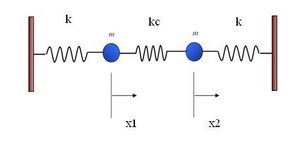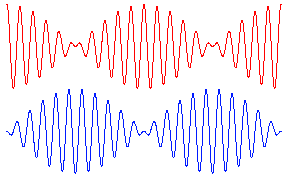Συνεζευγμένη Ταλάντωσις




- Ένα είσος ταλάντωσης.
Ετυμολογία[]
Η ονομασία "συνεζυγμένη" σχετίζεται ετυμολογικά με την λέξη "σύζευξη".
Περιγραφή[]
The harmonic oscillator and the systems it models have a single degree of freedom. More complicated systems have more degrees of freedom, for example two masses and three springs (each mass being attached to fixed points and to each other). In such cases, the behavior of each variable influences that of the others. This leads to a coupling of the oscillations of the individual degrees of freedom. For example, two pendulum clocks (of identical frequency) mounted on a common wall will tend to synchronise. This phenomenon was first observed by Christiaan Huygens in 1665.[1] The apparent motions of the compound oscillations typically appears very complicated but a more economic, computationally simpler and conceptually deeper description is given by resolving the motion into normal modes.
More special cases are the coupled oscillators where energy alternates between two forms of oscillation. Well-known is the Wilberforce pendulum, where the oscillation alternates between an elongation of a vertical spring and the rotation of an object at the end of that spring.
Μαθηματική Έκφραση[]
Consider two equal bodies (not affected by gravity), each of mass, m, attached to three springs, each with spring constant, k. They are attached in the manner as shape where the edge points are fixed and cannot move.
We'll use x1(t) to denote the horizontal displacement of the left mass, and x2(t) to denote the displacement of the right mass.
If we denote acceleration (the second derivative of x(t) with respect to time) as , the equations of motion are:
Since we expect oscillatory motion of a normal mode (where ω is the same for both masses), we try:
Substituting these into the equations of motion gives us:
Since the exponential factor is common to all terms, we omit it and simplify:
And in matrix representation:
For this to be generically true for any amplitude, the matrix on the left must be singular i.e. must not be invertible, such that one cannot multiply both sides of the equation by the inverse, leaving the right matrix equal to zero. It follows that the determinant of the matrix must be equal to 0, so:
Solving for , we have two positive solutions:
If we substitute ω1 into the matrix and solve for (A1, A2), we get (1, 1). If we substitute ω2, we get (1, −1). (These vectors are eigenvectors, and the frequencies are eigenvalues.)
The first normal mode is:
Which corresponds to both masses moving in the same direction at the same time.
The second normal mode is:
This corresponds to the masses moving in the opposite directions, while the center of mass remains stationary.
The general solution is a superposition of the normal modes where c1, c2, φ1, and φ2, are determined by the initial conditions of the problem.
The process demonstrated here can be generalized and formulated using the formalism of Lagrangian mechanics or Hamiltonian mechanics.
Υποσημειώσεις[]
Εσωτερική Αρθρογραφία[]
Βιβλιογραφία[]
Ιστογραφία[]
|
Αν και θα βρείτε εξακριβωμένες πληροφορίες "Οι πληροφορίες αυτές μπορεί πρόσφατα Πρέπει να λάβετε υπ' όψη ότι Επίσης, |
- Μην κάνετε χρήση του περιεχομένου της παρούσας εγκυκλοπαίδειας
αν διαφωνείτε με όσα αναγράφονται σε αυτήν
- Όχι, στις διαφημίσεις που περιέχουν απαράδεκτο περιεχόμενο (άσεμνες εικόνες, ροζ αγγελίες κλπ.)
















